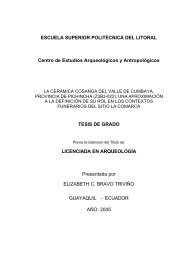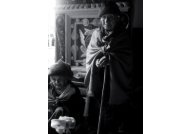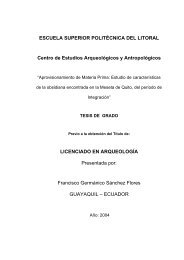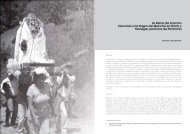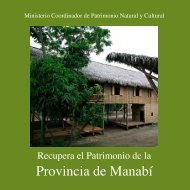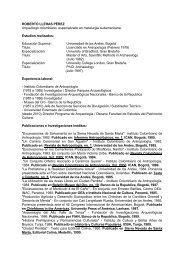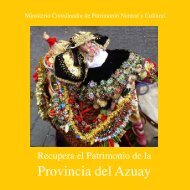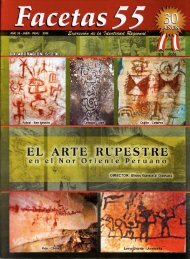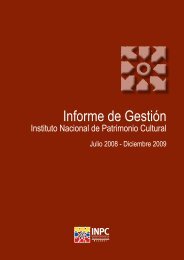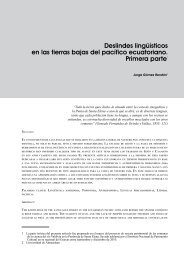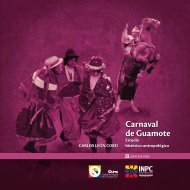INCAS PAST AND PRESENT - Stanford University
INCAS PAST AND PRESENT - Stanford University
INCAS PAST AND PRESENT - Stanford University
- No tags were found...
You also want an ePaper? Increase the reach of your titles
YUMPU automatically turns print PDFs into web optimized ePapers that Google loves.
<strong>Stanford</strong> Journal of ArchaeologyABSTRACTHere I explore the role of Inca-ness in the current conception and expression ofidentity among the Saraguro people of Ecuador and the potential role of archaeology inexamining, expressing, and exploiting the connections between them and their past. Asan ethnic group, the Saraguros have developed through a process of ethnogenesis inwhich members of several disparate groups forged a new identity in the context of Incaand Spanish colonialism. In the current construction of their ethnicity, the Saragurosexpress a close link to the Incas in numerous ways, including belief in common descentfrom the Incas.This strong connection with an Inca past has implications for the relationshipsbetween the Saraguros, archaeologists, archaeological sites, and archaeologicalresearch. Saraguros have become increasingly interested in learning about the pastthrough archaeology, especially about the local Inca presence. Likewise, they areinterested in preserving Inca sites and in their potential for stimulating tourism. Inturn, archaeologists have the potential to contribute to the Saraguros’ understanding ofand relationship with the past. Saraguro is a case that, in line with SAA ethicalprinciples, presents a very favorable opportunity to consult actively with localdescendants and establish working relationships that can be mutually beneficial.Dennis Ogburn 135
<strong>Stanford</strong> Journal of Archaeologylowland rain forests to the east (Belote 1984; Tual 1979). In contrast to many othernative Andean groups, the Saraguros managed to retain most of their ancestral lands,and as a result of this, as well as their success in cattle raising and other pursuits, as agroup they are among the most prosperous indigenous people in Ecuador, perhapssecond only to the Otavalos of the northern highlands.As the town of Saraguro is located along the Pan-American Highway, theSaraguros are by no means isolated from the greater Ecuadorian society, and their livesand circumstances are rapidly changing with the rest of the nation. For example, manySaraguros are frequent computer and internet users, and as of 2005, cell phone servicebecame available and was widely adopted. While a large proportion of Saraguros stillmake their living through agriculture and cattle raising, many are now attaining higherlevels of education, including university degrees and beyond, and are branching outinto new occupations such as law, education, and medicine. Along with changes intheir economic well-being, the Saraguros are becoming politically active, seeking toplay a greater role in issues that directly affect them. On the local stage, Saraguros haveformed a number of political organizations, and the indigenous community is having agreater impact in the government of the canton of Saraguro. Saraguros are also visibleon the national political stage, with a notable highlight being the election of anindigenous Saraguro, Luis Macas, to the national legislature in 1996. Recently, Macaswas elected to serve another term as head of the Confederación de NacionalidadesIndígenas del Ecuador (CONAIE), the national indigenous organization. Still, in theface of all of these major changes, the Saraguros are determined to assert theirindependence and maintain their ethnic identity.THE DEVELOPMENT OF SARAGURO ETHNIC IDENTITYAs with all other indigenous groups in the former realm of the Incas, the nature ofSaraguro ethnic identity has undergone a long process of change from the time of theIncas to the present, subjected to an array of both internal and external pressures. Theprocess of Saraguro ethnogenesis has been complex, entailing the development of adistinctive new, cohesive ethnic identity that arose from a collection of people ofdiverse origins (synthetic ethnogenesis) and the on-going definition and re-definition ofSaraguro ethnic identity (transformative ethnogenesis). 1 Here, the intent is to limit thediscussion to the aspects of the development of Saraguro ethnicity that are mostrelevant to how they conceive of and relate to the past.1Synthetic and transformative processes of ethnogenesis were defined in Belote and Belote (1993).Transformative ethnogenesis among the Saraguros was examined in that work and in Belote (1984),while synthetic ethnogenesis in Saraguro has been explored by Ogburn (forthcoming).Dennis Ogburn 137
<strong>Stanford</strong> Journal of ArchaeologyPre-Inca and Inca TimesThe seminal event in the history of the Saraguros was the arrival of the Inca Empire inthe southern highlands of Ecuador. The Inca army, under command of Topa Inca, thetenth emperor, conquered the region during the reign of his father, Pachacuti, theninth emperor and initiator of the Inca campaigns of conquest (Cabello Balboa 1945[1586]: 305; Cieza de León 1985 [1553]: 163; Murúa 1946 [1605]: 51; Rowe 1985:224; Sarmiento de Gamboa 1942 [1572]: 119). According to the chronology put forthby Rowe (1946: 203), the Inca conquest of Saraguro occurred between the years 1463and 1471. By the end of effective Inca rule in the 1530s, the area had been subject tothe Inca Empire for over six decades. Though it is a short period in archaeologicalterms, sixty years was certainly long enough for the Incas to consolidate their controlover the natives and integrate the area into the empire by imposing their ownadministrative, economic, and religious systems.Most importantly, the Incas instituted resettlement projects in Saraguro, asthey did in nearly every province of their empire. As a standard method ofconsolidating their control over newly conquered territories, the Incas forced manythousands of their subjects to relocate to provinces up to 2,000 km from their originalhomes, replacing them in turn with subjects from elsewhere in the empire. Peoplepermanently relocated by the state outside of the land of their ethnic origin wereknown in Quichua as mitmaqkuna (mitmaq in the singular). The chief aim of this policywas to pacify newly subjugated peoples by breaking them into smaller, more isolatedgroups, over whom control could be maintained by severely curtailing their ability toorganize resistance to their conquerors. However, some resettlements were alsocarried out for economic, religious, or other ends, depending on the needs of theempire.In their resettlement projects, the Incas did not simply make even exchangesbetween two provinces, but instead moved people in from and out to numerous areas,significantly increasing the ethnic diversity within each. As a result, a province mayhave contained people from a dozen or more ethnic groups, where there had formerlybeen perhaps three at the most. For example, the Inca placed mitmaqkuna from up tofifteen different ethnic groups in the region of Abancay in Perú (Espinoza Soriano 1973:232). The proportion of people replaced in each province varied greatly, rangingbetween perhaps 10% to 80% of the total population (Rowe 1982: 107). In somecases, such as Ayaviri and Paria near Lake Titicaca, the entire original population mayhave been removed (Julien 1993: 187). In the end, these massive resettlement projectshad a drastic effect on the ethnic landscape of the Andes, which is still evident today.Dennis Ogburn 138
<strong>Stanford</strong> Journal of ArchaeologyAccording to local oral traditions, the Incas subjected the Saraguro region tosuch resettlements, bringing in mitmaqkuna who were either ethnic Collas from theLake Titicaca region of Bolivia, or inhabitants of the Cuzco area, the capital of the IncaEmpire. Historical sources do not provide much information specific to the Saraguroregion, so the ethnic affiliation of the inhabitants in pre-Inca times has been unclear, ashas the proportion of the population removed by the Incas. Some documentary sources(e.g., Cabello Balboa 1945 [1586]; Cristóbal de Albornoz 1967 [late 16th century])associate Saraguro with the Paltas, who are thought to have inhabited much of thecentral and southern sections of the province of Loja. In contrast, evidence fromarchaeological remains (Ogburn 2001), the distribution of toponymic elements (Beloteand Belote 1994a), and historical documents (Truhan 1996) suggests the people weremore closely affiliated with the Cañaris, who lived to the north of Saraguro in what arethe modern provinces of Azuay and Cañar.With the extensive mixing of populations perpetrated by the Incas, themaintenance and expression of ethnic divisions and identities ceased to be solely a localprocess determined by each individual group in relation to its neighbors. Instead, thedynamics were conditioned by the dominant society, whose main interest was inmeasures that could be used to control its subjects. The Incas saw advantages inenforcing the maintenance of distinct identities of the dozens, if not hundreds, ofdifferent ethnic groups that comprised their empire. They instituted a number ofpolicies toward that end. For example, all subjects were required to maintain theoutward markers of their group affiliation, specifically clothing and headgear, and werenot allowed to assume the costume of any other ethnic group (Cobo 1979 [1653]:206). While many Inca policies, such as the imposition of the Quichua language and thestate religion, did serve to culturally unify the empire (Rowe 1982), this strategy offorced maintenance of ethnic divisions shows that the Incas were definitely not tryingto create a melting pot. Instead, the Incas were pursuing a policy that helped to controlthe provinces; the maintenance of ethnic distinctions helped perpetuate traditionalanimosities between neighboring groups and fueled suspicions of mitmaqkuna in theirnew lands, thus inhibiting the formation of alliances (Rowe 1982: 111).Therefore, whatever the ethnic make-up of the Saraguro region under theIncas, whether it included Collas, Cuzcos, Cañaris, Paltas, or others, members of eachgroup would have maintained separate ethnic identities, most likely living in separatesettlements, and serving different roles for the state.Dennis Ogburn 139
<strong>Stanford</strong> Journal of ArchaeologySpanish Rule to the PresentWhen the Spaniards arrived in the Andes, they too found ethnic differences to behelpful to their cause. During their conquest of the Incas, the surviving traditionaldivisions actually helped the Spaniards, as it inhibited native groups from uniting andorganizing a successful resistance, while other groups were all too ready to join theEuropeans to throw off the Inca imperial yoke (Rowe 1982: 94). But once theSpaniards had consolidated their control over the former Inca realm, their attitudetoward maintaining ethnic diversity changed significantly; they were no longerinterested in the continuation of traditional rivalries or ethnic divisions (Rowe 1982:94).This shift occurred because economics came to play a larger role in indigenousidentity than did political control. As under the Incas, the natives were required toserve the state by providing labor or goods. But now, local ethnic distinctions made nodifference to the dominant society; they only had an interest in maintaining a generalclass of indigenous people based on Spanish conceptions of race; this was the classwhose members were subject to forced labor and tribute because of their racial statusas indios. Thus, with such motivations, the Spaniards to a large extent imposed themaintenance of a generic indigenous identity on the native people (Belote and Belote1993: 3). Conditions under the Spaniards began to create “new pressures both forcultural unification and for the development of a sense of common identity” (Rowe1982: 94), leading to the consolidation of small ethnic entities, and an overall culturalhomogenization within the category of indigenous people. These processes werefurther encouraged by the reducciones of the late 16th century, in which the Spanishgovernment forced many people to move from their scattered settlements intoconcentrated towns; in many cases people of diverse ethnic backgrounds were forcedto live together (Murra 1946: 814).There were many other trends that led to a more homogenized indigenousidentity and the lessening of the importance of pre-Inca ethnic distinctions during theearly Spanish period. For instance, many people moved outside of their homeprovinces to escape the heavy tribute burden imposed upon property-owning natives,while many others were shuffled around to provide labor for such economic endeavorsas gold mining. On the other hand, during the chaos of the early years after the fall ofAtahuallpa in 1532, many mitmaqkuna returned to the homelands from which the Incashad removed them, thus re-affirming their original ethnic membership, and reducingthe ethnic diversity in some of the provinces. Within the context of this mixture ofpeoples and the external pressures to maintain only a generic indigenous identity, manyDennis Ogburn 140
<strong>Stanford</strong> Journal of Archaeologysmaller ethnic groups disappeared, others survived, and still others coalesced andforged distinct new identities.The indigenous people of the Saraguro region were certainly immersed in theseprocesses. The town of Saraguro itself was most likely founded by the Spaniards, asthere is no evidence of prehistoric settlement within the town itself (Ogburn 2001).During the Spanish period, the major obligation of the Saraguro natives was to maintainthe town's tambo, which was an important way station for travelers passing through thesouthern sierra. This uncompensated labor service was required of the Saraguros upuntil the 1940s (Belote and Belote 1993: 9). It may be that because the dominantsociety from the Spanish to the republican periods was most concerned with keeping asupply of free labor to maintain the tambo, the Saraguros were not greatly affected bythe hacienda system, which would have diverted their labor to the control of wealthyland owners (Belote and Belote 1993: 9). Thus while the Saraguros were subjected bythe state to a significant burden, they were left in control of their own lands.As was the case elsewhere in the Andes, the identification of the Saraguros asindigenous was to some extent enforced from the outside. But the native people of theSaraguro region did maintain an identity separate from their traditional neighbors, theCañaris to the north, who managed to flourish, and the Paltas to the south, who haveeffectively vanished as a distinct group. However, the pressures from outsideapparently led to a consolidation within the Saraguro region, among people withvarious ethnic affiliations, from various mitmaqkuna groups to whatever local peopleremained, and with some inter-marriage with mestizos and people of Europeandescent, forging a single more or less homogeneous group of Saraguros (Belote andBelote 1993: 8).In recent decades, the situation of the Saraguros has been changingsignificantly. Most importantly, they were freed from their uncompensated laborobligations to the state in the 1940s, and have been able to devote their efforts toexpanding their own economic base. As was noted above, many Saraguros have takenup cattle raising to participate in the cash economy, while others are engaging in nontraditionalcareers ranging from teaching to law. The Saraguros are also benefiting frommany national and international programs designated for indigenous peoples, and theyare becoming more politically active, forming organizations to express their views andpreserve their culture on a local level, while participating in pan-Ecuadorian indigenousorganizations on the national level.At this juncture, the changing economic and social conditions are such thatexternal pressures (i.e., policies and attitudes of the dominant society) have much lessinfluence on the maintenance of distinct indigenous ethnic identities. The process hasDennis Ogburn 141
<strong>Stanford</strong> Journal of Archaeologybecome chiefly an internal matter (Belote and Belote 1993: 5-15), and the Saragurosare now very actively seeking to maintain their identity as an indigenous ethnic groupon their own terms.SARAGURO IDENTITY <strong>AND</strong> THE <strong>PAST</strong>With this strong desire to maintain their ethnicity, there has been a conscious effortamong Saraguros in recent decades to preserve certain aspects of their culture thatoutwardly express their identity as Andean natives. Foremost among these are the useof the Quichua language, the prevalence of which had been waning but is now the focusof significant revival efforts (King 2001), and their distinctive traditional clothing andhairstyle (Belote 1984: 55). On another level, links with the past have become anessential element in how the Saraguros distinguish themselves as a group from allothers, native and non-native. However, in Saraguro, expressing that link with the pastis problematic because that past is very poorly known. As noted above, the identity ofthe pre-Inca natives of the region has been unclear, and the affiliation of the mitmaqkunabrought into the region by the Incas is likewise ambiguous. Additionally, while amajority of the forebears of the Saraguros were undoubtedly indigenous, it may neverbe determined what percentage represent mitmaqkuna, the descendants of the pre-Incainhabitants, or forasteros, who were those who left their homes during Spanish rule toavoid the high tribute requirements of the landed natives.Despite all this ambiguity, when their origins are discussed, in their oraltraditions the Saraguros emphasize their descent from mitmaqkuna, either Collas fromLake Titicaca, or Cuzcos from the center of the Inca Empire. Unfortunately, there is alack of known ethnohistorical documentation to either supplement or contradict theoral history, although available sources have certainly been examined for relevantinformation (especially by Belote 1984; Belote and Belote 1994b; Ogburn 2001). Onetantalizing piece of evidence is a document reported from a Spanish archive, whichstates that the Saraguro mitmaqkuna were elite troops in the Inca army (Belote andBelote, eds., 1994: 11-12). Otherwise, very few of the earliest chronicles mentionSaraguro by name, and those that do yield little data. When mitmaqkuna are mentioned,it is only in the larger context of the province of Loja. This dearth of descriptionprevails despite the location of Saraguro along the main north-south Andean highlandroute between Quito and Cuzco. Most likely, this situation arose from the hostility ofthe natives of the Saraguro region toward the Spaniards and other indigenous people(Cieza de León 1984 [1553]: 250, 1994 [1554]: 174; Arias Dávila 1897 [1582]: 178);this hostility seems to have made Spaniards avoid the area for at least 15 years after thetoppling of the last independent Inca ruler in the 1530s.Dennis Ogburn 142
<strong>Stanford</strong> Journal of ArchaeologyOn the whole then, the past of the Saraguros is primarily informed throughoral history, which presently does not provide much specific detail. Their knowledge oftheir origins is somewhat vague and does not seem to satisfy those Saraguros withwhom I have discussed the issue. Even the suggestion that their mitmaqkuna ancestorscame from Cuzco or Lake Titicaca appears to be another point of ambiguity, as if thereshould have been only one source group, and having two candidates means that thecertainty of either is questionable to them. But when considered in the context of Incapolicies of resettlement, the presence of multiple ethnic groups is actually the mostlikely scenario; the mitmaqkuna ancestors were probably from both regions, and couldhave come from other provinces as well.Belief in a shared origin is a common and often essential component of ethnicidentity. How then, in lieu of having a firm understanding of their mitmaqkuna origins,do the Saraguros express their common connection to the past, such an importantaspect of their identity? Currently, I see them addressing that question by activelylinking their identity directly to the Incas, a people and culture who are well-known tothe outside world. While little is known of whether any ethnic Incas were ancestors ofthe Saraguros, ethnohistorical and archaeological data leave no doubt that the Incaswere present and in control of the region. Of course, many contemporary highlandAndean indigenous groups exhibit some cultural relationships to the Incas, such as theuse of the Inca language, Quichua, but many of these links are remnants of former Incadomination rather than expressions of affinities for the Inca past. But for the Saraguros,the expressed associations are more explicit, and take a variety of forms.The traditional clothing of the Saraguros (FIGURE 2) is the most visible link tothe Incas; it is commonly said that they wear black as a sign of mourning for the deathof the last Inca, Atahuallpa. It would be difficult to determine whether this notionactually dates back to the death of Atahuallpa in 1533, or to more recent times (andperpetuated in part through tourist guidebooks). The connection between theSaraguros’ black clothing and the death of Atahuallpa was being expressed in the early20th century, as noted by Presbítero Ignacio Landívar Argudo (1996 [1946]). Earlier,Pedro Fermín Cevallos (1986 [1886]: 270), in his late 19th century history of Ecuador,noted that the black was a sign of mourning for the Saraguros’ lost independence.Though Cevallos' account does not refer directly to Atahuallpa, the sentiment ofmourning was present, and leads one to wonder whether the explicit mention ofAtahuallpa is a modern addition or was present in Cevallos' time as well. As a recentaddition, it would show a more conscious effort to link with the Inca past, but if thebelief dates farther back, then it would suggest much more of a historical connectionwith the Incas. One also might speculate that the wearing of black as a sign of mourningDennis Ogburn 143
<strong>Stanford</strong> Journal of Archaeologywas a European custom introduced to the Andes. In that case, this Saraguro customcould not date to the actual death of Atahuallpa because there would have been littletime for indigenous people to adapt such a foreign practice within the short periodbetween the arrival of Pizarro in 1532 and Atahuallpa's execution the next year.However, Rowe (1946: 246) describes the wearing of black during mourning as anInca custom, so the wearing of clothes of mourning by the Saraguros could indeed havegreat antiquity. No matter the age of the practice, the relevant point is that theSaraguros are in the present actively associating the Incas with the traditional Saragurostyle of dress, which is a source of pride and an important marker of their ethnicidentity (Belote 1984: 55).Direct Inca connections have also been made through the naming of schools inthe rural communities of Saraguro and business establishments in the town itself. Forexample, the schools in the communities of Tambupamba and Oñacapac have beennamed for two of the Inca Emperors, Huayna Capac and Tupac Yupanqui, respectively,while the school in Pichic is named for Rumiñahui, a famous Inca general who resistedthe Spanish conquest. Others directly incorporate the word Inca in their names, as with‘Inca Samana’ in Ilincho, and ‘Inca Huasi’ in Ñamarín. The school in Las Lagunas isnamed for the Inca festival of the sun, Inti Raymi, replacing the previous name ‘BenitoJuárez.’ In the more remote community of Ciudadela, the school was given theQuichua name “Amawta Hatari” and decorated with Inca related pictures (FIGURE 3).Of all of the possible names that could be chosen, it is striking that so many of theSaraguro schools, which are important community institutions, are explicitly linked byname to the Incas. The trend to give Inca-related names to rural schools has been goingon since the 1980s; more recently Saraguros have begun to give Inca-related names tobusinesses within the town of Saraguro. For example, in the past few years, theInkapirka restaurant was opened on the main plaza, and elsewhere some Saraguros havebegun a tour guide business named Inka Tours.On a personal level, some Saraguros are now giving Inca and Quichua firstnames to their children instead of the traditional Spanish names that have beencommonly used for centuries. For example, a number of boys have been namedAtahuallpa, a very assertive expression of Inca-ness. In a different vein, a friend of minenamed his daughter Inti Takatina, which means “she chases the sun.”In addition, the Incas are evoked through the performance of traditional musicin Saraguro, which is also being actively preserved and used in the expression,definition, and assertion of Saraguro ethnic identity (Volinsky 1996). The link with theIncas is expressed in two ways. First, one of the young groups of Saraguros involved inthe revitalization of traditional music have named themselves Grupo Rumiñahui, afterDennis Ogburn 144
<strong>Stanford</strong> Journal of Archaeologythe Inca general. Secondly, song lyrics of at least a few recent compositions haveincluded the names of Incas and other references to things Inca.Furthermore, the Saraguros are connecting themselves to an Inca past throughpublic ceremonies. For example, there has been a revival of the celebration of IntiRaymi, the Inca festival of the sun that takes place during the June solstice. During thisfestival, a large number of Saraguros gather to perform re-created rituals at the Bañodel Inca (‘Bath of the Inca’), a basin located within a waterfall next to a cave overlookingthe Pan-American Highway. Local lore holds that the Incas used to bathe in theBaño del Inca, where there is supposedly a seat carved into the bedrock from which thebasin is formed. The site does exhibit evidence of modification by the Incas, and cavesand waterfalls were sacred places in Inca religion, so it is likely that the Baño del Incawas actually used by the Incas for ceremonies. The revival of Inti Raymi began over adecade ago on a local level, centered in the community of Las Lagunas, and featuredperformances of school children dressing up in Inca costumes and the focal ceremony atthe Baño del Inca. Inti Raymi is now developing into a major tourist event, with acalendar of events lasting four days, and is advertised in the city and province of Lojavia posters and brochures (FIGURE 4). The events are now drawing many spectatorsfrom Loja and show the potential to draw increasing crowds in the future. Inti Raymiseems to be simultaneously putting Saraguro on the tourist map and proclaiming theInca-ness of the Saraguros to the outside viewer.Another ceremony, conducted in October of 1994 by one of the Saraguropolitical organizations, had a very explicit Inca connection, involving a procession toand ceremony at the Inca imperial site of Ciudadela. Also known as Tambo Blanco, thisis the best known archaeological site in the region, as it has been visited and describedfor centuries (Cieza de León 1984 [1553]: 180; Uhle 1923: 11; Villavicencio 1858:445-6). These events were held on October 11, the day before Columbus Day,referred to as the Day of Resistance, and were held to protest the more than 500 yearsof lost independence that began with the arrival of Columbus. At the head of theprocession to Ciudadela was a flag carrier with a rainbow flag, which is the modernsymbol for Andean indigenous people; notably, it was also a symbol used by the Incas.The ceremony at Ciudadela was held in the ruins of a large structure, of the typecommonly known as a kallanka. The ceremony included a speech in Quichua, whichreferred to the presence of the Incas at the site in the past, and how such importantleaders as Rumiñahui and Atahuallpa had gazed upon the very same stones that we sawbefore us.Perhaps the most conspicuous examples of explicit links to the Inca past beingexpressed by the Saraguros are found in community signage and in public architecture.Dennis Ogburn 145
<strong>Stanford</strong> Journal of ArchaeologyFor example, on a large sign painted at the northern entrance of the town of San Lucas,where it can be clearly seen by everyone passing by on the Pan-American Highway, thetown name is written along with the phrase ‘Inca Culture’ in Spanish. This proclamationis no doubt related to the fact that the town is located near two Inca sites,Ciudadela, and Inkapirka (not to be confused with the much publicized Ingapirca to thenorth of the city of Cuenca), which is a ceremonial site constructed of the famous Incastyle of cut-stone architecture. But neither of those Inca sites has been developed fortourism and the casual traveler would have no knowledge of them. The indigenouspeople of the area are planning to develop the sites and attract visitors, but at themoment, the sign does not appeared to be aimed at generating interest in the localruins. It seems more likely that the local indigenous residents are declaring that theyare the living heirs of the Inca culture that is so evident in the nearby sites. Morerecently, there has been a sign erected at the entrance from the Pan-American Highwayto the community of Las Lagunas, emphasizing that the community is the home of theInti Raymi festival. On one level, this sign is oriented toward outsiders who may beinterested in coming to see the activities hosted during Inti Raymi. But on anotherlevel, it is almost as if the residents of Las Lagunas are declaring themselves to be themost “Inca” of all the Saraguro communities.On a grander scale, a large new portal with Inca-style architectural elementshas been erected at the central upper entrance to main plaza in the town of Saraguro(FIGURE 5). Interestingly, such a project had to be approved by and funded by themunicipal government, in which the Saraguros have had little influence until recently,being historically the domain of the mestizo population that has been the predominantpopulation in the town. Moreover, the portal does not actually contain any directreferences to the indigenous population. This may suggest that the portal was erectedas a symbol recognizing the indigenous people of Saraguro as an important componentof local society, most appropriately represented by references to Inca culture.Alternatively, the Inca gateway could be a way of asserting or appropriating a level ofInca heritage for the entire population of the town and surrounding region, which inpart could be oriented towards the development of tourism.With these rather visible expressions of connections, the Saraguros are to anextent appropriating the past of the Incas in order to make it their own. Yet why wouldthe Saraguros link their identity to a group with which the original relationship was oneof domination and colonization? It is likely to serve several purposes. First, it is aconnection with a known and venerated culture of the past, through which theSaraguros become linked with the respect and admiration now associated with theIncas. This is rather ironic in that the reign of the Incas was not at all a benevolent orDennis Ogburn 146
<strong>Stanford</strong> Journal of Archaeologypaternalistic one. All the subjects of the empire were required to labor for the state,and many of them resented the loss of their sovereignty and the punishments meted outby the Incas during their wars of imperial conquest and their suppression of rebellion.In fact, native rancor was a major reason why Francisco Pizarro was able to topple theInca regime, as many indigenous groups were quite willing to side with the Spaniards inthe hope of throwing off the yoke of oppression. But time has been kind to the memoryof the Incas, and the popular conception of their empire, in the Andes and abroad, isone of a majestic, noble, and benevolent state, to which many people attach a sense ofmystery. Furthermore, compared to the excesses of the Spanish regime, the Andeanpeople were probably, on the whole, better off under Inca control. In any case, anexpressed link with the Incas gives outsiders ready-made images to associate with theSaraguros, which are more easily digestible than vague references to ancestors fromCuzco or Lake Titicaca.Additionally, an association with the Incas gives the Saraguros a solid link withthe prehispanic past, which is necessary because a prehispanic origin is in effect thedefining element of indigenous ethnicity. While a tie with the reign of the Incas maypre-date the arrival of the Spaniards by fewer than 100 years, and does not allow claimsfor long tenure on the land as may be claimed by other indigenous groups, theimportant aspect of the relationship is that it pre-dates the arrival of the Europeans,thus affirming the Saraguros' status as original inhabitants as compared to mestizos orwhites. The chronometric shallowness of their connection to prehispanic times is oflittle import because there are no neighboring indigenous groups who might disputeclaims to the land.This phenomenon of indigenous Andean peoples expressly identifying with theIncas has been referred to as “Inca-ism” (in contrast, here I have used the term “Incaness”to describe similarities between a group and the Incas, which are not necessarilyconsciously expressed as linked with an Inca identity). Inca-ism is by no means a recentphenomenon, nor is it limited to the Saraguros; it has its roots in the period of Spanishrule. As John Rowe described:With growing resentment of Spanish oppression and the decline of oldlocal loyalties, the Inca tradition emerged as the obvious symbol sharedby the native peoples, which marked their common difference fromthe Spanish and represented their opposition to foreign domination.Ironically, it was Spanish policies as much as Inca ones that gave theformer subjects of the realm a sense of Inca national identity and adegree of cultural unification in the native tradition that we are onlyjust beginning to appreciate (Rowe 1982: 114).Dennis Ogburn 147
<strong>Stanford</strong> Journal of ArchaeologySalomon (1987) has also discussed the roots of Inca-ism among the Cañaris ofEcuador, which he sees arising in the 16th century in reaction to Spanish practices. Inthe 19th and 20th centuries, the phenomenon has often been more overtly political, asin Perú, where Inca-ism has been a major element in defining the identity of indigenouspeople and their place in society (Molinié 2004). In recent times, Inca-ism is somethingof a pan-Andean phenomenon, where the rainbow flag, an Inca symbol, is used torepresent and unify modern highland indigenous groups. In Ecuador, claims of Incaheritage are a major element of the indigenous political movement in the country, andmany indigenous groups specifically claim descent from the Incas (Benavides 2004: 48;Salomon 1987).Thus the Saraguro identification with Inca culture and history is in part amanifestation of a phenomenon of the late 20th and early 21st centuries, but also of aprocess that dates back to the Spanish period. But beyond that, the connection betweenthe Saraguros and the Incas has roots in the policies of the Inca Empire itself. What setsthe Saraguros apart is that the Saraguros acknowledge their non-local origins in linkingto an Inca past, while many indigenous groups stress their local origins (i.e., “we werehere before the Incas”) at the same time they express their Inca heritage.On another front, appropriating the past of other societies in the realms of art,dance, architecture, etc., for commercial purposes is becoming increasingly common.This is certainly true in the Central Andes, where archaeological tourism is a hugeindustry, and references to the Incas can be used in many ways to gain tourist dollars.This is not yet the case with the Saraguros, as most of their expressions of Inca-nesshave served instead the ends of expressing and reinforcing identity. They have onlybegun to draw on Inca heritage in realms in which they could directly benefiteconomically, as with the Inti Raymi festival. Otherwise, tourism has a minor impacton the region, as the few travelers who come to visit stay for the short durationnecessary to visit the Sunday market, and most of their business transactions, includingthe purchase of indigenous souvenirs, is done through mestizo-run businesses in town.But it is not the case that the Saraguros are ignoring such a market; a number of themhave opened restaurants, others are actively working to establish tour guide businesses,and there is much interest in developing ecological and archaeological tourism in theregion. It will be interesting to see how the Saraguros promote themselves and theirbusinesses if such plans move forward.Saraguro expressions of an Inca past are a major component of defining and redefiningthemselves as they assert their position in the wider world. Many of theseexpressions, while quite visible, are nonetheless not primarily intended for projectingan image to the public; few outsiders ever pass by the schools in the rural communities,Dennis Ogburn 148
<strong>Stanford</strong> Journal of Archaeologyand one would have to participate in the ceremonies to perceive their Inca connections.Thus these expressions are to a large extent internal, re-affirming the Saraguros' senseof group identity and membership. In the future, as the Saraguros further assertthemselves in Ecuadorian society, connections to an Inca past may become morepronounced and aimed at the general public, but for the present the externalpresentation may not be as important as the internal.SARAGUROS, ARCHAEOLOGY <strong>AND</strong> THE <strong>PAST</strong>Within the context of the nature of Saraguro ethnic identity and how they relate to thepast, we can more readily understand how the set of relations between indigenouspeople, archaeology, and the material remains of the past are currently manifested, andhow these may be addressed in future archaeological projects.Saraguros and Cultural RemainsPerhaps the relationship that is most conditioned by the nature of Saraguro ethnicidentity is that between the Saraguros and prehistoric materials. First of all, there areno known sites that are recognized as being mitmaqkuna settlements from the time ofthe Incas. Because of this situation, there is no tangible link between the indigenouspeople and prehistoric cultural remains. There are no archaeological materials that, tothe Saraguros, directly represent their past as mitmaqkuna.Second, Saraguros value Inca remains, as components of their expressedconnection with an Inca past. As mentioned above, the Saraguro region is home tosome notable Inca sites, such as Inkapirka and Tambo Blanco near San Lucas, andWillkamarka (a.k.a. Paredones or Villamarca) near the town of Paquishapa. The firsttwo sites are the most widely known in the region, and are often referred to when Incaruins are discussed. There is also a recent move to preserve and protect these sites fromlooting, coming mainly from the community leaders who see value in these sites as partof their heritage. The Day of Resistance ceremony conducted at Tambo Blanco clearlyillustrated the importance that Inca sites are attaining among the Saraguros.Third, the Saraguros perceive no relation to the pre-Inca inhabitants of theregion, who are known as the gentiles, a generic term commonly used to refer toprehispanic peoples in the Andes. As a result of this lack of kinship with the gentiles, theSaraguros view the pre-Inca archaeological sites and artifacts with little concern for thepreservation or protection of the settlements or material remains. Many Saraguros usethe lands comprising such sites for habitation, farming, and pasture, and have beenactively destroying prehistoric terraces for these pursuits. Most people are aware of thelocations of large sites, and certain artifacts, such as axes and mace heads, are collectedDennis Ogburn 149
<strong>Stanford</strong> Journal of Archaeologywhen encountered while working fields or clearing vegetation. Such artifacts areprobably valued as objects of curiosity, possibly having a monetary value, but theredoes not seem to be any open trade in them. Also, one category of artifact, the legs ofpolypod ceramics, which are referred to as gentil bishu, are valued for medicinalpurposes and are collected from sites and kept for future use (Lanclos and Ogburn1996).There are other situations where pre-Inca remains are willfully looted ordestroyed. There are actually some local huaqueros (looters), who intentionally dig ingentil sites in search of artifacts for collection and sale, yet the pursuit is not widespreadbecause most artifacts of the region are undecorated and are not sought after byoutsiders. Other looting is opportunistic, spawned by the folk belief that when one seesa flame coming out of the ground at night that it is the location of some sort oftreasure. Finally, graves of gentiles are seen as a source of an illness known as mal aire,and they are often dug up and the bones burned to prevent further outbreaks of thedisease (Lanclos and Ogburn 1996). However, there are a few Saraguros, mainlyseveral community leaders, who are interested in preserving the local pre-Inca remainsas a valuable resource that is part of the local patrimony. Yet the effort to protect thosesites is a greater task than preserving the smaller and less numerous Inca sites, andwould have a larger economic impact on landowners if they were restricted in the useof lands where pre-Inca sites are located.Archaeologists and Cultural RemainsCompared to other regions in the Andes, relatively little archaeology has beenconducted in the Saraguro region, either by Ecuadorians or foreigners. In the 19thcentury, a number of scholars (e.g., Caldas 1912; Villavicencio 1858) passed throughthe region, providing only basic descriptions of sites and little more. Even Vernau andRivet, who produced the most detailed and valuable early work on Ecuadorianarchaeology, Etnographie Ancienne de l'Equateur (Vernau and Rivet 1912), only provide abrief description of remains in the Saraguro region, and that is primarily a summary ofinformation synthesized from earlier sources. Scholarly archaeological work inSaraguro began with Max Uhle's (1923) investigations at the site of Tambo Blanco.Two decades later, Collier and Murra (1943) passed through the region during a largersurvey project, collecting data and reporting on a few local sites and the correspondingpre-Inca ceramics.More recently, James and Linda Belote have investigated Saraguro archaeology,even though their interest has been an off-shoot of their cultural anthropologicalstudies. Nonetheless, they have visited a number of sites in the region (Belote andDennis Ogburn 150
<strong>Stanford</strong> Journal of ArchaeologyBelote 1996) and produced a general outline of the area's prehistory (Belote 1984: 88-93). Kevin Leonard (1993) also did a limited exploration of Inca storage rooms nearSan Lucas. To the north of Saraguro, Mathilde Temme (1981, 1982) has been conductingwork for a number of years, but mostly outside Saraguro territory. In the 1990s, aprogram of excavation and restoration was undertaken at a a pre-Inca site to the southof Saraguro, led by the Ecuadorian archaeologist Jaime Idrovo (1996). My ownfieldwork included an investigation of the Inca occupation and the effects of theirresettlement projects that was the first systematic survey in the region (Ogburn 2001).Finally, a number of other archaeologists, both foreign and Ecuadorian, have passedthrough the region and visited the more notable sites, without producing any reports orreturning for more involved work.However, this low level of archaeological investigation may soon give way toincreased fieldwork including large-scale excavations and restorations of certain sites.Much of the pressure for undertaking archaeology may come from the Ecuadoriangovernment itself, which, through the Instituto Nacional de Patrimonio Cultural(INPC), has in recent years been seeking sites as candidates for developingarchaeological tourism. For decades, Perú has benefited from the draw of itsspectacular and well-known prehispanic sites, especially such Inca settlements as Cuzcoand Machu Picchu, while the archaeological attractions in Ecuador have drawn farfewer visitors. The Ecuadorian situation results simply from the fact that none of thecountry's prehistoric sites approach the grandeur or renown of those of Perú, and thematerial culture is likewise lacking in impressiveness. Unfortunately, the Inca site thatwould have had the most potential, the Inca center of Tomebamba, was destroyed inthe Inca civil war for succession, and is now buried underneath the modern city ofCuenca. Many other Inca sites have been stripped of their cut stone for local buildingprojects. As it stands, the only Inca site open for tourism that is comparable to sites inPerú is Ingapirca, in the province of Cañar to the north of Cuenca. With few otherexceptions, there has not been a great effort to develop tourist-oriented archaeologicalsites in Ecuador, where tourism has been based instead on ecological, geographical, andcultural attractions.Given the economic potential of its archaeological resources, the Ecuadoriangovernment has a vested interest in controlling the investigation of majorarchaeological sites and how they are presented to the public. All archaeologicalmaterials, as part of the national patrimony, are property of the state, and thegovernment controls the conduct of archaeological fieldwork by requiring investigatorsto obtain permits from the INPC. The government has veto power over any project,and therefore has the ability to push its own agenda. Furthermore, the direction ofDennis Ogburn 151
<strong>Stanford</strong> Journal of Archaeologymajor archaeological projects could be subject to the whims of the director of theINPC, who may have little, if any, archaeological background. As an example, on oneoccasion after I completed a season of fieldwork, the then-head of the INPC urged meto come back to investigate the site of Tambo Blanco. On the spot, he called a friend ofhis on the Fulbright Commission to lobby for Fulbright funding for my return. This waswithout a clear understanding of what such a project would involve or how theSaraguros would perceive it. Lastly, because its director is appointed by the nation'spresident, and many employees could be replaced with a change in government, theINPC is by nature subject to political machinations and the agenda of whatever party isin control of the presidency. Currently, much of the work of the INPC is focused onCRM-type projects funded by multi-national corporations operating in the country.Nonetheless, the long-term trend is likely to involve a drive toward tourist-orientedarchaeological work, with Inca sites as a major focus, and Saraguro, with its locationalong the Pan-American Highway, may be high on the agenda.Saraguros and ArchaeologistsThe Saraguros' expressed origins as mitmaqkuna means that the subjects of much localarchaeology (the pre-Inca people) are not the ancestors of the indigenous people, andthat they have little stake in how that culture is interpreted and presented by outsiders.Those who do express an interest in such research are more concerned with actuallyhaving access to reports produced in order to learn about the prehistory rather thanwith contesting specific points of content or interpretation.The situation may be somewhat different regarding learning about Incaremains, because the Saraguros have more interest in them. But while their expressedconnections with the Inca past may be strong, I have not heard the investigation of Incasites explicitly equated with the study of the ancestors of the Saraguros. But because itis implicit, future investigations and representations of things Inca are likely to beclosely watched and have the potential to become subjects of contention.Given this context, the relationship of Saraguros and archaeologists is not andwill not be one of outside investigator and passive native observer. A number ofSaraguros, including many community leaders and others active in politics, have anactive interest in the local archaeology, both as a subject inherently worthy ofinvestigation and as a possible avenue of investigating their own past. Like other peoplein the area, many of these interested Saraguros have collected artifacts, but more withan interest in preserving them than to collect curiosities for keepsakes or for possiblesale. Not only are they interested in the Inca Period archaeology that would have aDennis Ogburn 152
<strong>Stanford</strong> Journal of Archaeologydirect connection with their people, they are also becoming concerned withinvestigating and preserving the pre-Inca sites.Beyond this interest in archaeology, many of these Saraguros have actuallyparticipated in archaeological fieldwork, from the organized excavations of MathildeTemme, to the more informal investigations of the Belotes, to my own survey projects.As participants, they not only gained knowledge about the results of fieldworkconducted in the region, but have gained practical experience that can allow them tointerpret archaeological information and assess other cultural resources. TheseSaraguro men and women will be the ones most involved in future archaeologicalinvestigations in the region. Perhaps because of their exposure to archaeology in thefield and through formal education, and because there has been little contention witharchaeologists over the right to investigate the region's past or the legitimacy ofinterpretations, these Saraguros have a favorable view of archaeology.Of course, there are Saraguros who harbor different attitudes towardarchaeologists, attitudes mostly centered on issues of exploitation and land ownership.For example, mainly for fear of robbery, some Saraguro land owners do not wishforeigners (or even other indigenous people) to set foot on their land for any reason.Many would rather not have people conducting fieldwork on their property, for fear ofdamage to valuable pasture or farmland. It does not seem to be an issue yet inSaraguro, but Ecuadorian laws regarding patrimony allow the state to appropriate landcontaining archaeological sites, so Saraguro landowners may understandably resist anyinvestigations within their land holdings. Finally, archaeological projects may besuspect because many Saraguros fear commercial exploitation that does not compensatethem for the resources extracted or for any damage to the environment. Manyindigenous people throughout Ecuador are fully aware of and alarmed at the extractionof petroleum in the lowland rain forests, which has devastated the environment whilecontributing little or nothing to the people whose land is being exploited.People with such objections to archaeological investigation, whatever theirbasis, may contest future fieldwork, but it is the Saraguros with an active interest inarchaeology who will have a greater say in determining the course of futurearchaeology in the region. Members of the latter group do not conceive of archaeologyas simply the pursuit of outsiders who come to exploit their past or the local culturalresources, but rather perceive it as a tool that can serve their own ends. Namely, it canbe used to investigate their own past, to finally shed light on the many questions abouttheir origins. Outside archaeologists, then, become potential sources of funding andexpertise, and can provide work, experience, and information. For their part, theDennis Ogburn 153
<strong>Stanford</strong> Journal of ArchaeologySaraguros have the desire to participate for both the knowledge and the trainingarchaeology can provide.Future Archaeological InvestigationUnder these circumstances, with little contention between indigenous people andarchaeology, and a primarily favorable attitude toward participation and investigationon the part of the Saraguros, there are a number of ways that the academic goals offuture archaeological projects can complement the interests of Saraguros regarding thepast. Moreover, this is a case where there is a clear opportunity for archaeologists toconsult actively with local groups and establish working relationships beneficial to thediscipline and all involved, in line with the ethical principles of the Society forAmerican Archaeology (Kintigh 1996: 17).Perhaps the most important question that could be pursued archaeologically isthe matter of the mitmaqkuna origins of the Saraguros. Specifically, could there be anyevidence of whether their ancestors were actually mitmaqkuna, and if so, to whichethnic group(s) did they belong? What roles did they play in the Inca government,economy, and religion? Where are their settlements in the Saraguro area, and whatwas their material culture like? My current research addresses many of these questions,yet the results from the survey are mostly suggestive rather than definitive. Furtherfieldwork, especially excavations, will be needed to provide more solid answers tothese questions, and must deal critically with the thorny issue of identifying ethnicgroups in the archaeological record.Secondly, investigations at the local Inca sites and survey of the Inca roadsystem could complement the Saraguros' links to the Inca past by expanding knowledgeof what the Incas did in the region. Excavations could provide information on site plansand functions, material culture, and increase understanding of local economics andgovernment under the Incas. Inca sites, such as Inkapirka and Tambo Blanco, could alsobe excavated and preserved for tourism, though the ramifications of such plans shouldbe carefully considered before implementation. Many people, including Saraguros andmestizos from inside and outside the area have expressed interest in undertaking suchprojects.Finally, archaeological fieldwork can contribute to the local museum that isbeing constructed by the municipal government in the center of Saraguro, in part topromote tourism. Archaeology could provide specimens for display and informationuseful for presenting the history of the region, and in this case, artifacts from the pre-Inca culture would be as useful as would Inca or mitmaqkuna materials. Excavations atDennis Ogburn 154
<strong>Stanford</strong> Journal of Archaeologythe pre-Inca sites would also be of interest to those Saraguros who wish to learn aboutall of the region's prehistory.Research goals that incorporate such investigations could easily be formulatedby archaeologists to meet academic goals. For example, the mitmaqkuna question isimportant in the context of Andean archaeology, because the forced resettlementscarried out by the Incas had a drastic effect on the ethnic landscape in all of the Incarealm, and it is essential for archaeologists to understand the issue if they wish tocomprehend regional systems during the Inca Period. Investigations at provincial Incasites can be used to address any number of issues related to imperial expansion andmaintenance.In the end, almost any problem that can be addressed in the archaeologicalrecord of Saraguro could complement the desires of its indigenous inhabitants,provided they are included in the process of investigation and have access to the results.Future projects, especially long-term or large-scale research programs, could bedeveloped in direct consultation with the Saraguros most concerned with learningabout the past, including leaders of indigenous organizations, people involved in themuseum, and those with the most active personal interests in archaeology. Saragurosshould be involved in as many aspects of the research as is feasible, including planning,fieldwork, laboratory work, publication, etc.. Access to formal archaeological trainingwould also train future archaeologists to develop and carry out projects as well as helppreserve local archaeological resources.CONCLUSIONSAs in any other region where archaeologists and the descendants of their subject ofstudy interact, the relationships between the indigenous Saraguros, archaeology, andthe past are complicated. Yet, in Saraguro the nature of indigenous ethnic identity,with a strong expressed connection to the Incas, tempered by a dearth of fieldwork inthe area, has not led to a state of contention about the investigation, interpretation, andpresentation of the past. Instead there is a favorable environment where the goals ofeach side can be seen to be complementary and amenable to future work. It would bebeneficial to have a similar situation throughout the Andes, but the circumstances of theSaraguro region are not likely to pertain to many other situations, and they certainlycannot be artificially created. Furthermore, the situation is likely to change asfieldwork in Saraguro increases. Instead of presenting a difficult problem of conflictbetween indigenous people and archaeologists, Saraguro offers the challenge ofsustaining a state of favorable relations between both sides and how they deal with thepast. Above all, “it is important that archaeologists incorporate the process ofDennis Ogburn 155
<strong>Stanford</strong> Journal of Archaeologyconsultation and cooperation” in future archaeological research, as Watkins et al.(1995: 37) urge for archaeology in general.ACKNOWLEDGEMENTSI would like to thank Linda and Jim Belote for providing me with their informativeworks relating to their research in Saraguro, and Nan Volinsky for sending mematerials relating to the indigenous music of Saraguro. I also thank Donna Lanclos,Robin Sewell, and Elizabeth Prine for her help in editing earlier incarnations of thispaper, and the anonymous reviewer for comments on the revised version. Any errors,factual or otherwise, remain my own.REFERENCESAlbornoz, Cristóbal de. “La Instrucción para Descubrir Todas las Guacas del Pirú y SusCamayos y Haziendas” edited by P. Duviols. Journal de la Société desAméricanistes, 55(1) (1967 [late 16 th century]).Arias Dávila, Pedro. “Pacaibanba ó Leoquina.” In Relaciones Geográficas de Indias, TomoIII, edited by M. Jiménez de la Espada, 177-81. Ministerio de Fomento,Madrid, 1897 (1582).Belote, James D. “Changing Adaptive Strategies among the Saraguros of SouthernEcuador.” Ph.D. diss., <strong>University</strong> of Illinois at Urbana-Champaign, 1984.Belote, James D., and Linda S. Belote. “From the Incas to OPEC: A Process of AndeanEthnogenesis.” Ms. in possession of the author, 1993.Belote, James D., and Linda S. Belote. “Toponyms and Saraguro Origins (Toponimos yLos Origenes de Los Saraguros).” Ms. on file, Biblioteca de la Comunidad deSan Lucas, Ecuador, 1994a.Belote, James D., and Linda S. Belote. “Algunas Fuentes Para el Estudio de la Historiay Cultura de los Saraguros.” Ms. on file, Biblioteca de la Comunidad de SanLucas, Ecuador, 1994b.Belote, James D., and Linda S. Belote. “Archaeological Survey of Northern LojaProvince, Ecuador, 1969-1994: Sites, Structures, & Artifacts.” Ms. inpossession of the author, 1996.Belote, Linda S. and James D. Belote, editors. Los Saraguros: Fiesta y Ritualidad.Colección de Antropología Aplicada, No.9. Quito: Abya-Yala, 1994.Benavides, O. Hugo. Making Ecuadorian Histories: Four Centuries of Defining Power.Austin: <strong>University</strong> of Texas Press, 2004.Cabello Balboa, Miguel. Obras, Vol.1. Quito: Editorial Ecuatoriana, 1945 (1586).Dennis Ogburn 156
<strong>Stanford</strong> Journal of ArchaeologyCaldas, Francisco J. de. Obras de Caldas. Biblioteca de Historia Nacional, Volume IX.Bogotá: Imprenta Nacional, 1912.Cevallos, Pedro F. Historia del Ecuador/6. Quito: Ilustre Municipio de Ambato, 1986(1886).Cieza de León, Pedro de. La Crónica del Perú Primera Parte. Lima: Pontificia UniversidadCatólica del Perú Fondo Editorial, 1984 (1553).Cieza de León, Pedro de. La Crónica del Perú Segunda Parte (El Señorío de los Incas). Lima:Pontificia Universidad Católica del Perú Fondo Editorial, 1985 (1553).Cieza de León, Pedro de. La Crónica del Perú Cuarta Parte. Vol.II Guerra de Chupas. Lima:Pontificia Universidad Católica del Perú Fondo Editorial, 1994 (1554).Cobo, Bernabé. History of the Inca Empire. Translated by R. Hamilton. Austin:<strong>University</strong> of Texas Press, 1979 (1653).Collier, Donald and John V. Murra. Survey and Excavation in Southern Ecuador.Anthropological Series Volume 35. Chicago: Field Museum of NaturalHistory, 1943.Espinoza Soriano, Waldemar. “Colonias de Mitmas Multiples en Abancay, Siglos XV yXVI.” Revista del Museo Nacional XXXIX (1973):225-99.Idrovo Urigüen, Jaime. “Paisaje histórico, identidad y tecnologías andinas; Unareferencia a San Lucas y los Saraguros.” Identidad 2 (1996):22-87. Cuenca:Instituto de Civilización Andina INKA.Julien, Catherine J. “Finding a Fit: Archaeology and Ethnohistory of the Incas.” InProvincial Inca: Archaeological and Ethnohistorical Assessment of the Impact of the IncaState, edited by M.A. Malpass, 177-233. Iowa City: <strong>University</strong> of Iowa Press,1993.King, Kendall A. Language Revitalization Processes and Prospects: Quichua in the EcuadorianAndes. Clevedon, UK: Multilingual Matters, 2001.Kintigh, Keith. “SAA Principles of Archaeological Ethics.” SAA Bulletin 14, no.5 (1996):17.Lanclos, Donna M. and Dennis E. Ogburn. “The Potential Uses of Folklore inArchaeological Research.” Paper read at the 61st Annual Meeting of theSociety for American Archaeology, New Orleans, 1996.Landívar Argudo, P.I. “El Indio Saragurense, su origen, sus costumbres.” Identidad 3(1996):88-94. Cuenca: Instituto de Civilización Andina INKA.Leonard, Kevin. “Archaeological Reconnaissance in the Province of Loja, Ecuador:The 1992 CEDIC-CESO Project.” Ms. on file, Centro de Difusión Cultural(CEDIC), Quito, 1993.Dennis Ogburn 157
<strong>Stanford</strong> Journal of ArchaeologyMolinié, A. “The Resurrection of the Inca: The Role of Indian Representations in theInvention of the Peruvian Nation.” History and Anthropology 15, no.3(2004):233-50.Murra, John V. “The Historic Tribes of Ecuador.” In The Andean Civilizations, edited byJ.H. Steward, 785-821. Handbook of South American Indians, vol. 2, J.H.Steward, general editor. Washington: Smithsonian Institution, 1946.Murúa, Martín de. Historia del Origen y Genealogía Real de los Reyes Incas del Perú.Introduction, notes and edition by Constantino Bayle. Biblioteca ‘MissionaliaHispánica’, Volume III. Madrid: Instituto Santo Toribio de Mogrovejo, 1946(1605).Ogburn, Dennis E. “Becoming Saraguro: Ethnogenesis in the Context of Inca andSpanish Colonialism.” Ethnohistory, forthcoming.Ogburn, Dennis E. “The Inca Occupation and Forced Resettlement in Saraguro,Ecuador.” Ph.D. diss, <strong>University</strong> of California, Santa Barbara, 2001.Rowe, John H. “Inca Culture at the Time of the Spanish Conquest.” In The AndeanCivilizations, edited by J.H. Steward, 183-330. Handbook of South AmericanIndians, vol. 2, J. H. Steward, general editor. Washington: SmithsonianInstitution, 1946.Rowe, John H. “Inca Policies and Institutions Relating to the Cultural Unification ofthe Empire.” In The Inca and Aztec States 1400-1800: Anthropology and History,edited by G.A. Collier, R.I. Rosaldo, and J.D. Wirth, 93-118. New York:Academic Press, 1982.Rowe, John H. “Probanza de los Incas Nietos de Conquistadores.” Histórica IX, no. 2(1985):193-245.Salomon, Frank. “Ancestors, Grave Robbers, and the Possible Antecedents of Cañari‘Inca-ism’.” In Natives and Neighbors in South America, edited by H.O. Skar andF. Salomon. Göteborg: Etnologiska Studier 38, 1987.Sarmiento de Gamboa, Pedro. Historia de los Incas. 2nd ed. Emecé Editores, BuenosAires, 1942 (1572).Temme, Mathilde. “Informe Sobre Algunas Construcciones Incaicas De InteresArquelogico, Cultural Y Turistico Dentro Y En La Cercania De LasPoblaciones De Los Indigenas Saraguros.” Ms. on file, Instituto Nacional dePatrimonio Cultural, Cuenca, 1981.Temme, Mathilde. “Excavaciones en el Sitio Preceramico de Cubilán (Ecuador).”Miscelánea Antropológica Ecuatoriana 2 (1982):135-64.Truhan, Deborah. “Saraguro: Pistas hacia su historia.” Identidad 1 (1996):62-69.Cuenca: Instituto de Civilización Andina INKA.Dennis Ogburn 158
<strong>Stanford</strong> Journal of ArchaeologyTual, Anny. “Apuntes Sobre Dos Migraciones de los Saraguros.” Revista de Antropología(Cuenca) 6 (1979):117-129.Uhle, Max. Las Ruinas de Tomebamba. Conferencia leída en el Centro de EstudiosHistóricos y Geográficos del Azuay. Quito:Julio Sáenz Rebolledo, 1923.Vernau, R. and Paul Rivet. Etnographie Ancienne de l'Equateur. Mission du ServiceGéographique de l'Armée pour la Mesure d'un Arc de Méridien Equatorial duSud sous le Controle Scientiphique de l'Académie de Sciences (1899-1906),Volume 6. Paris: Gauthier-Villars, 1912.Villavicencio, Manuel. Geografía de la Republica del Ecuador. New York: RobertCraighead, 1858.Volinsky, Nan L. “Ethnic Emergence and Violin Practice in Saraguro, Ecuador.” Paperread at the 95th Annual Meeting of the American Anthropological Association,San Francisco, 1996.Watkins, Joe, Lynne Goldstein, K. Vitelli, and L. Jenkins. “Accountability:Responsibilities of Archaeologists to Other Interest Groups.” In Ethics inAmerican Archaeology: Challenges for the 1990s, edited by M. Lynott and A.Wylie, 33-37. Washington: Society for American Archaeology, 1995.Dennis Ogburn 159
<strong>Stanford</strong> Journal of ArchaeologyILLUSTRATIONSFigure 1. Location of Saraguro in relation to Cuzco and other major places discussed inthe text.Dennis Ogburn 160
<strong>Stanford</strong> Journal of ArchaeologyFigure 2. Indigenous woman and man wearing typical Saraguro clothing (Photo byauthor).Figure 3. Amawta Hatari school in the community of Ciudadela, decorated withpictures of Incas (Photo by author).Dennis Ogburn 161
<strong>Stanford</strong> Journal of ArchaeologyFigure 4. Brochure advertising the Saraguro Inti Raymi festival, depicting a childdressed in traditional Saraguro clothing and an adult adorned with a combination ofInca and Saraguro elements (Loja Dirección de Turismo).Dennis Ogburn 162
<strong>Stanford</strong> Journal of ArchaeologyFigure 5. Newly constructed Inca-style gateway on the main plaza of Saraguro (Photoby author).Dennis Ogburn 163



